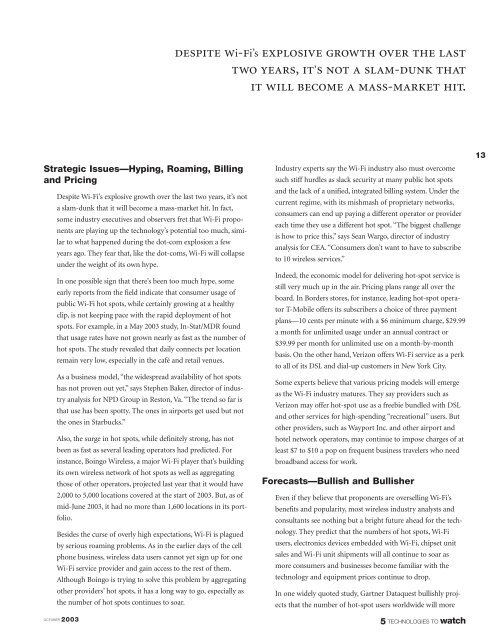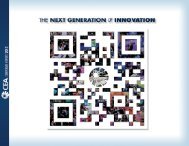TECHNOLOGIES TO watch - Consumer Electronics Association
TECHNOLOGIES TO watch - Consumer Electronics Association
TECHNOLOGIES TO watch - Consumer Electronics Association
Create successful ePaper yourself
Turn your PDF publications into a flip-book with our unique Google optimized e-Paper software.
DESPITE Wi-Fi’s EXPLOSIVE GROWTH OVER THE LASTTWO YEARS, IT’S NOT A SLAM-DUNK THATIT WILL BECOME A MASS-MARKET HIT.Strategic Issues—Hyping, Roaming, Billingand PricingDespite Wi-Fi’s explosive growth over the last two years, it’s nota slam-dunk that it will become a mass-market hit. In fact,some industry executives and observers fret that Wi-Fi proponentsare playing up the technology’s potential too much, similarto what happened during the dot-com explosion a fewyears ago. They fear that, like the dot-coms, Wi-Fi will collapseunder the weight of its own hype.In one possible sign that there’s been too much hype, someearly reports from the field indicate that consumer usage ofpublic Wi-Fi hot spots, while certainly growing at a healthyclip, is not keeping pace with the rapid deployment of hotspots. For example, in a May 2003 study, In-Stat/MDR foundthat usage rates have not grown nearly as fast as the number ofhot spots. The study revealed that daily connects per locationremain very low, especially in the café and retail venues.As a business model, “the widespread availability of hot spotshas not proven out yet,” says Stephen Baker, director of industryanalysis for NPD Group in Reston, Va. “The trend so far isthat use has been spotty. The ones in airports get used but notthe ones in Starbucks.”Also, the surge in hot spots, while definitely strong, has notbeen as fast as several leading operators had predicted. Forinstance, Boingo Wireless, a major Wi-Fi player that’s buildingits own wireless network of hot spots as well as aggregatingthose of other operators, projected last year that it would have2,000 to 5,000 locations covered at the start of 2003. But, as ofmid-June 2003, it had no more than 1,600 locations in its portfolio.Besides the curse of overly high expectations, Wi-Fi is plaguedby serious roaming problems. As in the earlier days of the cellphone business, wireless data users cannot yet sign up for oneWi-Fi service provider and gain access to the rest of them.Although Boingo is trying to solve this problem by aggregatingother providers’ hot spots, it has a long way to go, especially asthe number of hot spots continues to soar.OC<strong>TO</strong>BER 2003Industry experts say the Wi-Fi industry also must overcomesuch stiff hurdles as slack security at many public hot spotsand the lack of a unified, integrated billing system. Under thecurrent regime, with its mishmash of proprietary networks,consumers can end up paying a different operator or providereach time they use a different hot spot. “The biggest challengeis how to price this,” says Sean Wargo, director of industryanalysis for CEA. “<strong>Consumer</strong>s don’t want to have to subscribeto 10 wireless services.”Indeed, the economic model for delivering hot-spot service isstill very much up in the air. Pricing plans range all over theboard. In Borders stores, for instance, leading hot-spot operatorT-Mobile offers its subscribers a choice of three paymentplans—10 cents per minute with a $6 minimum charge, $29.99a month for unlimited usage under an annual contract or$39.99 per month for unlimited use on a month-by-monthbasis. On the other hand, Verizon offers Wi-Fi service as a perkto all of its DSL and dial-up customers in New York City.Some experts believe that various pricing models will emergeas the Wi-Fi industry matures. They say providers such asVerizon may offer hot-spot use as a freebie bundled with DSLand other services for high-spending “recreational” users. Butother providers, such as Wayport Inc. and other airport andhotel network operators, may continue to impose charges of atleast $7 to $10 a pop on frequent business travelers who needbroadband access for work.Forecasts—Bullish and BullisherEven if they believe that proponents are overselling Wi-Fi’sbenefits and popularity, most wireless industry analysts andconsultants see nothing but a bright future ahead for the technology.They predict that the numbers of hot spots, Wi-Fiusers, electronics devices embedded with Wi-Fi, chipset unitsales and Wi-Fi unit shipments will all continue to soar asmore consumers and businesses become familiar with thetechnology and equipment prices continue to drop.In one widely quoted study, Gartner Dataquest bullishly projectsthat the number of hot-spot users worldwide will more5 <strong>TECHNOLOGIES</strong> <strong>TO</strong> <strong>watch</strong>13










